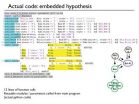(Press-News.org) The brains of jazz musicians engrossed in spontaneous, improvisational musical conversation showed robust activation of brain areas traditionally associated with spoken language and syntax, which are used to interpret the structure of phrases and sentences. But this musical conversation shut down brain areas linked to semantics — those that process the meaning of spoken language, according to results of a study by Johns Hopkins researchers.
The study used functional magnetic resonance imaging (fMRI) to track the brain activity of jazz musicians in the act of "trading fours," a process in which musicians participate in spontaneous back and forth instrumental exchanges, usually four bars in duration. The musicians introduce new melodies in response to each other's musical ideas, elaborating and modifying them over the course of a performance.
The results of the study suggest that the brain regions that process syntax aren't limited to spoken language, according to Charles Limb, M.D., an associate professor in the Department of Otolaryngology-Head and Neck Surgery at the Johns Hopkins University School of Medicine. Rather, he says, the brain uses the syntactic areas to process communication in general, whether through language or through music.
Limb, who is himself a musician and holds a faculty appointment at the Peabody Conservatory, says the work sheds important new light on the complex relationship between music and language.
"Until now, studies of how the brain processes auditory communication between two individuals have been done only in the context of spoken language," says Limb, the senior author of a report on the work that appears online Feb. 19 in the journal PLOS ONE. "But looking at jazz lets us investigate the neurological basis of interactive, musical communication as it occurs outside of spoken language.
"We've shown in this study that there is a fundamental difference between how meaning is processed by the brain for music and language. Specifically, it's syntactic and not semantic processing that is key to this type of musical communication. Meanwhile, conventional notions of semantics may not apply to musical processing by the brain."
To study the response of the brain to improvisational musical conversation between musicians, the Johns Hopkins researchers recruited 11 men aged 25 to 56 who were highly proficient in jazz piano performance. During each 10-minute session of trading fours, one musician lay on his back inside the MRI machine with a plastic piano keyboard resting on his lap while his legs were elevated with a cushion. A pair of mirrors was placed so the musician could look directly up while in the MRI machine and see the placement of his fingers on the keyboard. The keyboard was specially constructed so it did not have metal parts that would be attracted to the large magnet in the fMRI.
The improvisation between the musicians activated areas of the brain linked to syntactic processing for language, called the inferior frontal gyrus and posterior superior temporal gyrus. In contrast, the musical exchange deactivated brain structures involved in semantic processing, called the angular gyrus and supramarginal gyrus.
"When two jazz musicians seem lost in thought while trading fours, they aren't simply waiting for their turn to play," Limb says. "Instead, they are using the syntactic areas of their brain to process what they are hearing so they can respond by playing a new series of notes that hasn't previously been composed or practiced."
INFORMATION:
Along with Limb, other Johns Hopkins researchers involved in the study include Gabriel F. Donnay, B.S.; Summer K. Rankin, Ph.D.; Monica Lopez-Gonzalez, Ph.D.; and Patpong Jiradejvong, M.S.
This project was funded by the Dana Foundation and the Brain Science Institute of the Johns Hopkins University School of Medicine.
Study of jazz players shows common brain circuitry processes music and language
Researchers scanned brains while musicians 'traded fours'
2014-02-20
ELSE PRESS RELEASES FROM THIS DATE:
Study finds nothing so sweet as a voice like your own
2014-02-20
Have you ever noticed that your best friends speak the same way? A new University of British Columbia study finds we prefer voices that are similar to our own because they convey a soothing sense of community and social belongingness.
While previous research has suggested that we prefer voices that sound like they are coming from smaller women or bigger men, the new study – published today in the journal PLOS ONE – identifies a variety of other acoustic signals that we find appealing.
[NB: Article available at: http://dx.plos.org/10.1371/journal.pone.0088616]
"The ...
NIH team discovers genetic disorder causing strokes and vascular inflammation in children
2014-02-20
National Institutes of Health researchers have identified gene variants that cause a rare syndrome of sporadic fevers, skin rashes and recurring strokes, beginning early in childhood. The team's discovery coincides with findings by an Israeli research group that identified an overlapping set of variants of the same gene in patients with a similar type of blood vessel inflammation.
The NIH group first encountered a patient with the syndrome approximately 10 years ago. The patient, then 3 years old, experienced fevers, skin rash and strokes that left her severely disabled. ...
Two-thirds of women not taking folic acid before pregnancy to prevent spina bifida
2014-02-20
Research published today from Queen Mary University of London reveals less than 1 in 3 women have taken folic acid supplements before pregnancy to prevent spina bifida and other birth defects of the brain, spine, or spinal cord (neural tube defects). This is despite research from 1991 showing that such conditions could be prevented in most cases by increasing the intake of the B-vitamin folic acid before pregnancy.
The study, carried out by Queen Mary's Wolfson Institute of Preventive Medicine and published in the journal PLOS ONE, questioned nearly half a million women ...
Iron deficiency may increase stroke risk through sticky blood
2014-02-20
Scientists at Imperial College London have discovered that iron deficiency may increase stroke risk by making the blood more sticky.
The findings, published in the journal PLOS ONE, could ultimately help with stroke prevention.
Every year, 15 million people worldwide suffer a stroke. Nearly six million die and another five million are left permanently disabled. The most common type, ischaemic stroke, occurs because the blood supply to the brain is interrupted by small clots.
In the last few years, several studies have shown that iron deficiency, which affects around ...
Ants build raft to escape flood, protect queen
2014-02-20
When facing a flood, ants build rafts and use both the buoyancy of the brood and the recovery ability of workers to minimize injury or death, according to a study published in PLOS ONE on February 19, 2014 by Jessica Purcell from University of Lausanne, Switzerland, and colleagues. Furthermore, the queen ant is placed in the middle and protected on all sides by the rafting ants.
When put in harm's way, social animals are often able to work together to enhance the survival and welfare of the group. Ants living on flood plains are known to link to together to create rafts ...
Adding bevacizumab to initital glioblastoma treatment doesn't improve overall survival
2014-02-20
Glioblastoma (GBM) is the most common primary malignant adult brain tumor and, despite treatment advances in recent years, the average survival of patients enrolled in clinical trials is less than 16 months with few patients living beyond five years. GBM tumors are characterized by angiogenesis — the formation of new blood vessels that support tumor growth stimulated by the GBM-produced vascular endothelial growth factor A (VEGF-A). Bevacizumab is a monoclonal antibody that targets VEGF-A production to block the growth of tumor-derived blood vessels. "Clinical trials evaluating ...
Bevacizumab offers no benefit for newly diagnosed glioblastoma, MD Anderson-led study finds
2014-02-20
HOUSTON — The angiogenesis inhibitor bevacizumab (Avastin) failed to increase overall survival (OS) or statistically significant progression-free survival (PFS) for glioblastoma patients in the frontline setting, according to a study led by researchers at The University of Texas MD Anderson Cancer Center.
The study appears in the New England Journal of Medicine, and was first presented on the plenary session of the American Society of Clinical Oncology 2013 Annual Meeting by Mark Gilbert, M.D., professor in MD Anderson's Department of Neuro-Oncology.
Glioblastoma is ...
Bevacizumab (Avastin) fails to improve survival for newly diagnosed glioblastoma patients
2014-02-20
BALTIMORE – February 19, 2014. Adding bevacizumab (Avastin) to standard chemotherapy and radiation treatment does not improve survival for patients newly diagnosed with the often deadly brain cancer glioblastoma, researchers report in the Feb. 20 issue of the New England Journal of Medicine.
"We didn't see an improvement in overall survival or a statistically significant increase in progression-free survival, as defined in the context of this trial," says the study's senior author, Minesh P. Mehta, M.B., Ch.B., Professor of Radiation Oncology at the University of Maryland ...
SDSC team develops multi-scale simulation software for chemistry research
2014-02-20
Researchers at the San Diego Supercomputer Center at the University of California, San Diego, have developed software that greatly expands the types of multi-scale QM/MM (mixed quantum and molecular mechanical) simulations of complex chemical systems that scientists can use to design new drugs, better chemicals, or improved enzymes for biofuels production.
A paper outlining the research, titled 'An Extensible Interface for QM/MM Molecular Dynamics Simulations with AMBER' and conducted by members of the Walker Molecular Dynamics Lab (WMD) at SDSC, was featured on the cover ...
Clutter cutter
2014-02-19
WASHINGTON D.C. Feb. 19, 2014 -- Life can be messy at all scales, requiring different organizational strategies -- from cleaning the house, to removing damaged or expired cells from the body to avoid cancer progression.
In a messy house, people use computers to manage paper and photo clutter; companies use computer systems to track their inventory. Now a team of researchers at Vanderbilt University in Nashville, Tenn., is taking a similar approach to cell-molecular inventory control for cancer. They have created computer models, using their programming framework (PySB), ...
LAST 30 PRESS RELEASES:
Injectable breast ‘implant’ offers alternative to traditional surgeries
Neuroscientists devise formulas to measure multilingualism
New prostate cancer trial seeks to reduce toxicity without sacrificing efficacy
Geometry shapes life
A CRISPR screen reveals many previously unrecognized genes required for brain development and a new neurodevelopmental disorder
Hot flush treatment has anti-breast cancer activity, study finds
Securing AI systems against growing cybersecurity threats
Longest observation of an active solar region
Why nail-biting, procrastination and other self-sabotaging behaviors are rooted in survival instincts
Regional variations in mechanical properties of porcine leptomeninges
Artificial empathy in therapy and healthcare: advancements in interpersonal interaction technologies
Why some brains switch gears more efficiently than others
UVA’s Jundong Li wins ICDM’S 2025 Tao Li Award for data mining, machine learning
UVA’s low-power, high-performance computer power player Mircea Stan earns National Academy of Inventors fellowship
Not playing by the rules: USU researcher explores filamentous algae dynamics in rivers
Do our body clocks influence our risk of dementia?
Anthropologists offer new evidence of bipedalism in long-debated fossil discovery
Safer receipt paper from wood
Dosage-sensitive genes suggest no whole-genome duplications in ancestral angiosperm
First ancient human herpesvirus genomes document their deep history with humans
Why Some Bacteria Survive Antibiotics and How to Stop Them - New study reveals that bacteria can survive antibiotic treatment through two fundamentally different “shutdown modes”
UCLA study links scar healing to dangerous placenta condition
CHANGE-seq-BE finds off-target changes in the genome from base editors
The Journal of Nuclear Medicine Ahead-of-Print Tip Sheet: January 2, 2026
Delayed or absent first dose of measles, mumps, and rubella vaccination
Trends in US preterm birth rates by household income and race and ethnicity
Study identifies potential biomarker linked to progression and brain inflammation in multiple sclerosis
Many mothers in Norway do not show up for postnatal check-ups
Researchers want to find out why quick clay is so unstable
Superradiant spins show teamwork at the quantum scale
[Press-News.org] Study of jazz players shows common brain circuitry processes music and languageResearchers scanned brains while musicians 'traded fours'

